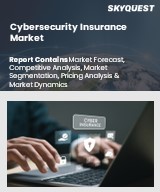
Report ID: SQMIG45E2248

Report ID:
SQMIG45E2248 |
Region:
Global |
Published Date: May, 2024
Pages:
197
|
Tables:
92 |
Figures:
69
Drivers
Cyberthreats are Becoming More Frequent and Sophisticated
Cybersecurity Regulations to Increase Demand for Cybersecurity Insurance
Restraints
Insufficient Knowledge about Cybersecurity Insurance
Lack of Information About Cybersecurity Insurance to Limit Development
Our industry expert will work with you to provide you with customized data in a short amount of time.
REQUEST FREE CUSTOMIZATIONWant to customize this report? This report can be personalized according to your needs. Our analysts and industry experts will work directly with you to understand your requirements and provide you with customized data in a short amount of time. We offer $1000 worth of FREE customization at the time of purchase.

Report ID: SQMIG45E2248